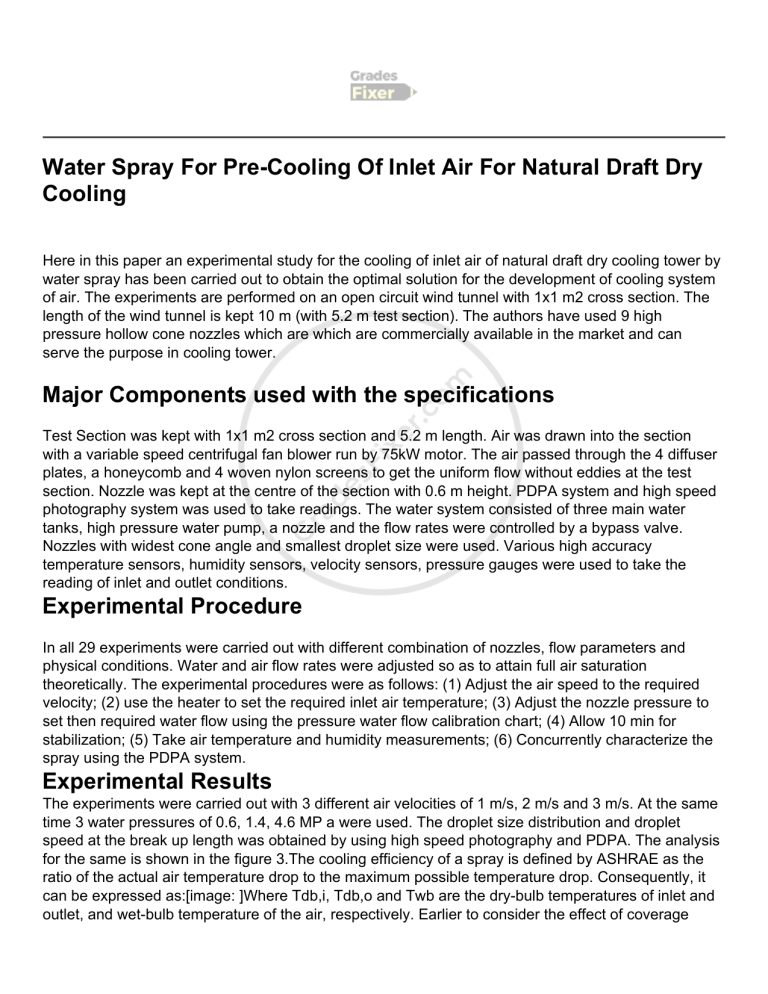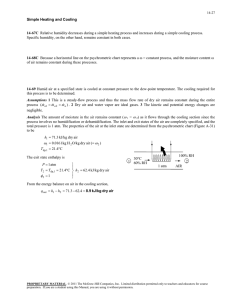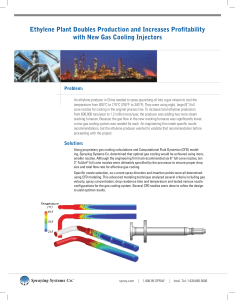
Water Spray For Pre-Cooling Of Inlet Air For Natural Draft Dry Cooling Here in this paper an experimental study for the cooling of inlet air of natural draft dry cooling tower by water spray has been carried out to obtain the optimal solution for the development of cooling system of air. The experiments are performed on an open circuit wind tunnel with 1x1 m2 cross section. The length of the wind tunnel is kept 10 m (with 5.2 m test section). The authors have used 9 high pressure hollow cone nozzles which are which are commercially available in the market and can serve the purpose in cooling tower. Major Components used with the specifications Test Section was kept with 1x1 m2 cross section and 5.2 m length. Air was drawn into the section with a variable speed centrifugal fan blower run by 75kW motor. The air passed through the 4 diffuser plates, a honeycomb and 4 woven nylon screens to get the uniform flow without eddies at the test section. Nozzle was kept at the centre of the section with 0.6 m height. PDPA system and high speed photography system was used to take readings. The water system consisted of three main water tanks, high pressure water pump, a nozzle and the flow rates were controlled by a bypass valve. Nozzles with widest cone angle and smallest droplet size were used. Various high accuracy temperature sensors, humidity sensors, velocity sensors, pressure gauges were used to take the reading of inlet and outlet conditions. Experimental Procedure In all 29 experiments were carried out with different combination of nozzles, flow parameters and physical conditions. Water and air flow rates were adjusted so as to attain full air saturation theoretically. The experimental procedures were as follows: (1) Adjust the air speed to the required velocity; (2) use the heater to set the required inlet air temperature; (3) Adjust the nozzle pressure to set then required water flow using the pressure water flow calibration chart; (4) Allow 10 min for stabilization; (5) Take air temperature and humidity measurements; (6) Concurrently characterize the spray using the PDPA system. Experimental Results The experiments were carried out with 3 different air velocities of 1 m/s, 2 m/s and 3 m/s. At the same time 3 water pressures of 0.6, 1.4, 4.6 MP a were used. The droplet size distribution and droplet speed at the break up length was obtained by using high speed photography and PDPA. The analysis for the same is shown in the figure 3.The cooling efficiency of a spray is defined by ASHRAE as the ratio of the actual air temperature drop to the maximum possible temperature drop. Consequently, it can be expressed as:[image: ]Where Tdb,i, Tdb,o and Twb are the dry-bulb temperatures of inlet and outlet, and wet-bulb temperature of the air, respectively. Earlier to consider the effect of coverage area readings were plotted for full cross section of the tunnel and the graph for the same is mention in the figure 4. It was observed that half the area remains unaffected with spray so to measure the actual cooling efficiency the portion(area) where 5% change in temperature occurred was taken into consideration and the graphs were plotted again which is shown in the figure 5. This shows that mainly half area of the test section is affected by nozzle spray. Also it is observed that larger cooling area is obtained at 1m/s velocity compared to the other two. The reason behind this is for the lower velocity the residence time of the droplets is higher in the cooling area as compared with the higher velocities which results in better evaporation better humidification and better cooling. The below mention figure 7 shows the relationship between the drop let size, spray cone angle and coverage efficiency. It is observed that for the small droplet formations better coverage area is obtained whereas the effect of spray cone angle is mostly uncertain on the coverage area. It should be noted that in practice we can use extra nozzle to increase the coverage area of the air washer. High pressure water jet results in larger no. of small droplets. Air velocity and Droplet size formation are the majority drivers of water spray cooling. Effect of the coverage area on cooling efficiency is greatly considerable and provision for extra spray nozzles should be made to increase coverage area as well as cooling efficiency. Increase in air velocity results in results in decreased cooling efficiency as well as coverage area. Smaller droplet size results in better cooling efficiency. For the droplet size of less than 60 micrometer the coverage area ratio is independent of air velocity which shows that the maximum coverage area has been reached. For the most efficient cooling low air velocities and small droplet size distributions are required. Need Help With The Assignment? Our professionals are ready to assist with any writing! GET HELP




